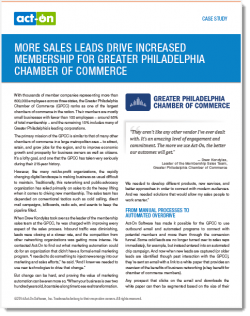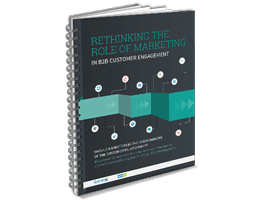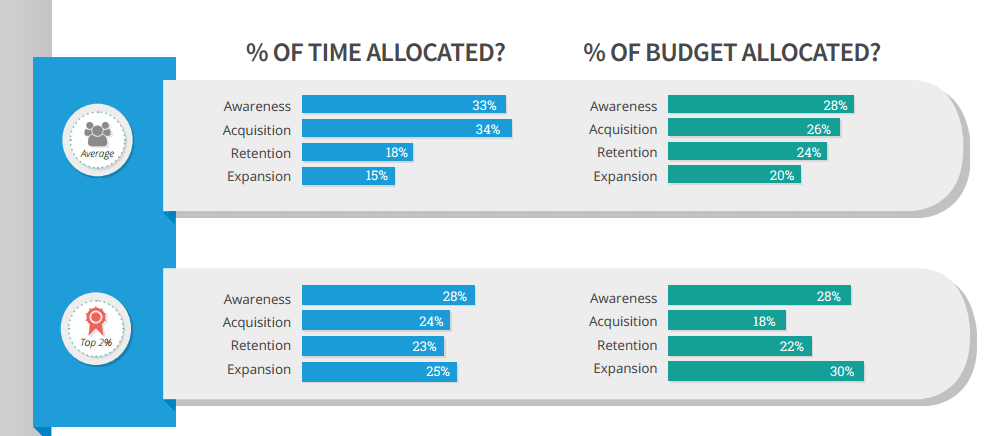 Most B2B marketing teams spend a lot of their time and money on customer acquisition. And that makes sense, because generating new leads is often their primary goal, and many marketers are measured by their success in creating sales-qualified leads. But what happens to those leads after sales takes over? What’s marketing’s job when it comes to meeting customer needs after conversion?
Most B2B marketing teams spend a lot of their time and money on customer acquisition. And that makes sense, because generating new leads is often their primary goal, and many marketers are measured by their success in creating sales-qualified leads. But what happens to those leads after sales takes over? What’s marketing’s job when it comes to meeting customer needs after conversion?
It’s easy to get fixated on acquisition revenue. But according to recent research, this single-minded focus is changing. A new report from Gleanster and Act-On, Rethinking the Role of Marketing, reveals that top performing marketing teams are taking full control of the customer lifecycle – going beyond customer awareness and acquisition to conversion, retention and expansion.
Why? Because the research also indicates that the top performing teams spend far more time and resources on building engagement with their existing customers.
As you can see, top performing companies allocate more time and effort on customer retention and expansion. Retention activities don’t require a lot of budget, but they do take a lot of time. The average B2B marketer throws money at retention but doesn’t take the time to personalize efforts.
Top performing companies also invest more marketing budget on getting found and up-selling to existing customers. They invest more time and effort personalizing campaigns and addressing customer preferences (unlike average firms).
These divergent approaches play out in revenue. Average companies achieve 30% of revenue from their established customer base, while top performers acquire 50% of their revenue this way. So 20% – that’s a huge difference. It’s even more significant when you consider that revenue from retention and expansion can be more predictable – and profitable – than revenue from new customer acquisition.
What gets measured tends to get done. Take a tip from top performers: make sure marketing has measurable objectives in the later lifecycle stages of expansion and retention. Objectives translate to strategic effort, which in turn leads to more repeat sales for your company.
 The companion eBook to the Gleanster and Act-On survey report, Marketing: The New Stewards of the Customer Relationship, outlines four key recommendations to help B2B organizations realize the same results as the top performers. One of the recommendations is simple: Pay more attention to how you engage with existing customers. Of course, it’s simple to say, but not always easy to do. Here’s an example of how the Greater Philadelphia Chamber of Commerce (GPCC), Act-On customer and customer retention superstar, manages to make it happen:
The companion eBook to the Gleanster and Act-On survey report, Marketing: The New Stewards of the Customer Relationship, outlines four key recommendations to help B2B organizations realize the same results as the top performers. One of the recommendations is simple: Pay more attention to how you engage with existing customers. Of course, it’s simple to say, but not always easy to do. Here’s an example of how the Greater Philadelphia Chamber of Commerce (GPCC), Act-On customer and customer retention superstar, manages to make it happen:
Keeping Connected with Customers
The primary mission of the GPCC is similar to that of many other chambers of commerce in a large metropolitan area – to attract, retain, and grow jobs for the region, and to improve economic growth and prosperity for business owners as well as citizens. It’s a lofty goal, and one that the GPCC has taken very seriously during their 215-year history.
However, like many not-for-profit organizations, the rapidly changing digital landscape is making business as usual difficult to maintain. Traditionally, this networking and public-advocacy organization has relied primarily on sales to do the heavy lifting when it comes to driving new membership. The sales team has depended on conventional tactics such as cold calling, direct mail campaigns, billboards, radio ads, and events to keep the pipeline filled.
 While the GPCC started out using Act-On to generate leads and increase sales, they quickly discovered that the email automation and lead scoring features could also be used to improve engagement for their members. “Keeping our customers happy is important,” said Drew Kondylas, leader of the membership sales team. “And the ability to measure that engagement is key.”
While the GPCC started out using Act-On to generate leads and increase sales, they quickly discovered that the email automation and lead scoring features could also be used to improve engagement for their members. “Keeping our customers happy is important,” said Drew Kondylas, leader of the membership sales team. “And the ability to measure that engagement is key.”
Using Act-On lead scoring, they’re developing a baseline of customer satisfaction as well as how likely their members are to recommend the GPCC to other businesses. They’ll be able to more effectively maintain and even upsell services like advertising and special events such as ribbon-cutting ceremonies.
“It’s really exciting to continue to not only drive sales and leads but also to move from purely a business-development focus to a long-term member engagement strategy,” Drew said.
It’s an approach that’s leading to better engagement and more upsell opportunities. The biggest improvement has been demonstrated in the top-line results for membership dues collected – in fact, they increased by 20% year-over-year, from FY2013, before Act-On, to FY2014, after implementation. Read the case study to learn more about how marketing automation can help your marketing team go beyond focusing on acquisition to ensuring better customer retention and expansion.
 Check out the full results of the survey from Gleanster and Act-On and get tips for solving the top challenges B2B marketers face in a rapidly changing marketplace. Download the report to learn how the most successful organizations are approaching customer lifecycle engagement in the new era of B2B marketing. And be sure to check out the companion eBook, Marketing: The New Stewards of the Customer Relationship to get more recommendations for improving customer engagement and re-defining marketing’s role in CRM.
Check out the full results of the survey from Gleanster and Act-On and get tips for solving the top challenges B2B marketers face in a rapidly changing marketplace. Download the report to learn how the most successful organizations are approaching customer lifecycle engagement in the new era of B2B marketing. And be sure to check out the companion eBook, Marketing: The New Stewards of the Customer Relationship to get more recommendations for improving customer engagement and re-defining marketing’s role in CRM.

